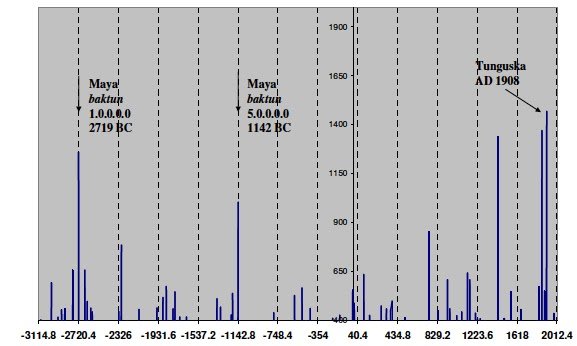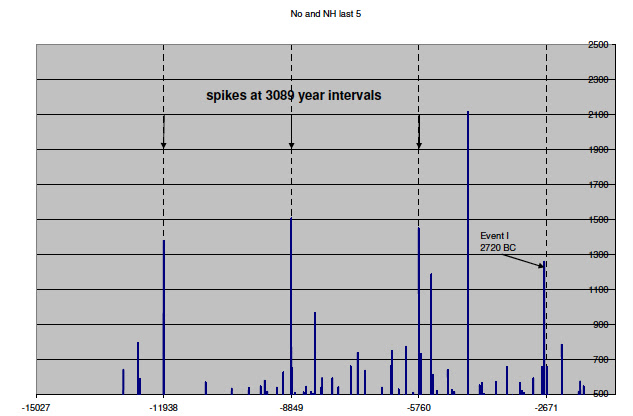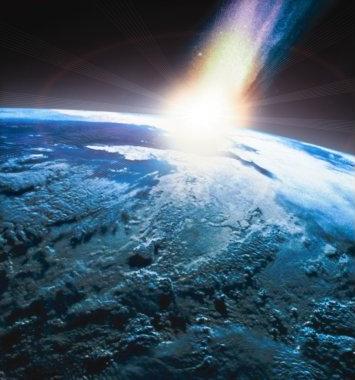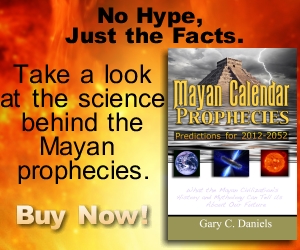TheRealMayanProphecies.com » Featured, Mayan Calendar, News » Why the Maya calendar starts in 3114 BC
Why the Maya calendar starts in 3114 BC
Dr. Mike Baillie at the Queen’s University in Belfast, Ireland has made a very interesting discovery. He noticed that peaks in ammonium and nitrate in the ice core record, signatures of comet impacts with Earth, occur on or near baktun endings in the Mayan calendar. (The 13th and final baktun of the current calendar cycle ends on December 21, 2012.) This discovery suggests that the ancient Maya were aware of a cycle associated with repeated impacts of comets with Earth and that they engineered their calendar to track these cycles.
In his book The Order of Days, Mayan scholar David Stuart noted that these baktun endings were very important to the Maya and that they often constructed new temples and pyramids on these dates. He noted that the Temple of the Cross group of pyramids at Palenque were constructed on one such baktun ending.
As I noted in my book Mayan Calendar Prophecies: Predictions for 2012-2052, in Temple XIX at Palenque the Maya left a record of a great flood that occurred near the end of their previous calendar cycle in 3300 BC. I interpreted this “mythical” event as a record of a real oceanic impact event that created enormous mega-tsunamis around the world. Evidence for such events has been found in both the sedimentary and ice core records. The Mayan eyewitness accounts of these events were recorded in their historical chronicles known as Chilam Balam and are consistent with an impact event with associated mega-tsunamis. Thus Dr. Baille’s research provides further evidence that supports my hypothesis that the Mayan long count calendar was designed to track a cycle of impact events which was the basis of their religious beliefs. Read his research below and decide for yourself:
Why the Maya calendar starts in 3114 BC: a possible explanation
by M G L Baillie, School of Geography, Archaeology and Palaeoecology, The Queen’s University, Belfast
The 13 baktun Mayan Long Count calendar spans 3114 BC to AD 2012; each baktun being 144,000 days. The calendar was probably devised by a gifted individual or group of astronomers (hereafter GIGA) in the 1st millennium BC who chose 3114 Aug 11 (proleptic Gregorian calendar equivalent) as the start date. How or why this choice was made has long been a mystery. Evidence from the chemistry of the American GISP2 ice core may provide a simple solution. GISP2 yielded records of ammonium (NH4) and nitrate (NO3). Plotting a combined index of NH4 plus NO3 against the original GISP2 timescale (Figure 1) is a revelation. The two highest NH4/NO3 indices in some six millennia – between 4558 BC and AD 1427 – occur within a year of two baktun transitions in the Mayan calendar; namely mean ice dates 2720.4 BC cf baktun 1.0.0.0.0 (2719 BC), and 1142.8 BC cf baktun 5.0.0.0.0 (1142 BC).

Figure 1. Index of (NH4%+NO3%) in GISP2 ice showing high values 1577 years apart at 2720.4 BC and
1142.8 BC; chemistry and dates from the ice record (Mayewski et al. 1997). Maya baktun changes and
Tunguska (1908) are indicated.
Elsewhere it has been pointed out that NH4/NO3 occurred in the GISP ice at AD 1908.48 coincident with the Tunguska impact of 30 June 1908 (Baillie 2007; Melott et al. 2010). This makes it reasonable to suggest that some real physical atmospheric phenomena (almost certainly cosmic) recorded 1577 years apart in the layer-counted ice record, may have been noticed by Maya/Olmec ancestors.
The hypothesis
The Mayan Long Count placement may be explained by a simple mechanism, namely that people witnessing Event I (around 2720 BC) initiated a year count. Their descendants noted a repeat Event II in 1142 BC and continued counting years thereafter.
If such a year count existed, then, at any date after 1142 BC the GIGA would have had an important fact to work with. It is believed that the Maya knew that the solar year was just less than 365.25 days. If the GIGA were aware of that year length, and of ancient lore “that two extra-ordinary sky events had occurred 1577 years apart n years ago” they could have deduced: 1577 years x 365.25 days = 575,999.25 days; exquisitely close to 576,000 days. The GIGA would also have been aware of numbers such as 18 x 20 = 360, the number of days in the approximate year, and 20 x 20 = 400; they may well have known that 400 x 360 = 144,000. With 1577 years as a prompt, how long would it have taken them to realize that 4 x (20 x 20) x (18 x 20) = 576,000 days?
When actually devising the calendar, the GIGA would know there had been four major divisions of time (4 x 144,000 days) between Events I (1.0.0.0.0) and II (5.0.0.0.0), and would also know the number of years (hence days) since Event II (1142 BC). Since 1.0.0.0.0 was clearly the catastrophic end of a time period, the beginning could be guessed to be 144,000 days before 1.0.0.0.0, namely 3114 BC. So nothing at all needs to have happened in 3114 BC for that year to become the start year of the Mayan calendar.
As to the choice of start day in 3114 BC: knowing that five units of 144,000 days fall between the start of the epoch and Event II (1142 BC), and knowing the number of years (n) since 1142 BC, the GIGA could arbitrarily have declared that “today we are living (5 x 144,000) + (n x 365.25) days since the start of this epoch”. Thus, the day of the year the declaration was made would determine the start date, though this could have been tweaked using other knowledge. Deciding on 13 baktuns may have been dictated by other Tzolkin/Haab considerations, by symmetry, or by 13 being a significant number.
Referring to Figure 1 there is insufficient data to decide whether any major catastrophic event is due during 2012 (when 13.0.0.0.0 occurs). However, the large ammonium/nitrate spikes circa AD 1427 and 1861 urgently require adequate explanation. Finally, all credit to the GISP2 ice-layer counters, whose efforts appear vindicated.
References Cited
Baillie, M.G.L. 2007 The case for significant numbers of extraterrestrial impacts through the late Holocene. Journal of Quaternary Science 22, 101-109. doi:10.1002/jqs.1099
Mayewski, P.A., L.D. Meeker, M.S. Twickler, S.I. Whitlow, Q. Yang, W.B.Lyons, and M. Prentice. 1997. Major features and forcing of high-latitude northern hemisphere atmospheric circulation using a 110,000-year-long glaciochemical series. Journal of Geophysical Research 102:26345-26366.
Mellott, A.L., Thomas, B.C., Dreschoff, G. and Johnson, C.K. 2010 Cometary airbursts and atmospheric chemistry: Tunguska and a candidate Younger Dryas event. Geology38, 4, 355-358. doi: 10.1130/G30508.1
Additional Information
Data: GISP2 ice data is from The Greenland Summit Ice Cores CD-ROM. 1997. Available from the National Snow and Ice Data Center, University of Colorado at Boulder, and the World Data Center-A for Paleoclimatology, National Geophysical Data Center, Boulder, Colorado. The GISP2 NH4/NO3 indices were produced by converting raw ammonium and nitrate values to percentages of the mean of the 5 previous values in the ice core record, and adding the resulting percentages. The horizontal scale is based on means of the top and bottom ice core dates for each sample, pre-AD 1950.
Perspective
Identification of a possible cosmic origin for the 2720 BC and 1142 BC NH4/NO3 spikes encourages investigation of the remainder of the Post Glacial GISP2 record. Figure 2 shows a continuation of the previous plot.

Figure 2: Index of (NH4%+NO3%) in GISP2 ice showing high values 3089 years apart at 11938 BC, 8849
BC and 5760 BC; chemistry and dates from the ice record (Mayewski et al. 1997). Event I from Figure 1 is
indicated.
It is immediately apparent that the first three major Post Glacial NH4/NO3 spikes, at 11,938 BC, 8849 BC and 5760 BC, are spaced at 3089 year intervals. This may hint at a cosmic origin for these three peaks. It has to be noted that the 2720 BC peak is 3040 years after 5760 BC which means that an association with the preceding three cannot be ruled out. The 8849 BC spike is interesting because it is preceded in the ice by a 15cm sample showing an anomalously large NaCl signal, perhaps hinting at an ocean impact. The enormous, apparently stochastic 4559 BC NH4/NO3 deposition could span up to 4 years in the ice compared with the 3.5 months associated with Tunguska. Each of these events in the GISP2 record requires additional investigation. Unfortunately no equivalent long records are available from the European suite of ice cores, though the forthcoming NEEM Greenland chemistry record may allow confirmation of the presented events.
Filed under: Featured, Mayan Calendar, News · Tags: comet impact event, ice core record, impact event, mayan calendar
One Response to "Why the Maya calendar starts in 3114 BC"
Leave a Reply
You must be logged in to post a comment.





[…] And Preparing For EnlightenmentDid a comet hit Earth the last time the Mayan calendar endedWhy the Maya calendar starts in 3114 BCvar base_url_sociable = […]